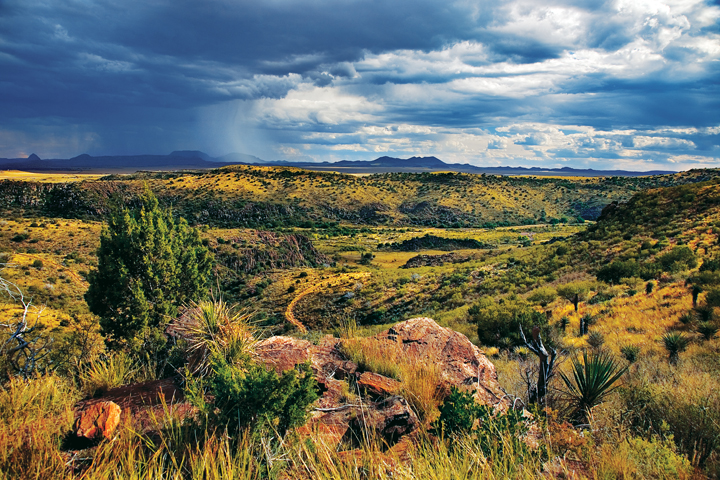
A view of Limpia Canyon on the R.M. Sproul Ranch shows storm clouds skirting the horizon. (Photo by E. Dan Klepper)
From under the porch shade of a peaceful, secluded, rock-faced getaway near Fort Davis, the fading sunlight tangles with pastures and palisades, rising and falling along the mountain topography. In these waning days of summer, late-afternoon rays always tug against the shadows as if dusk were a game, making the tussle of day and night seem whimsical against the landscape’s expanse. Night ultimately wins out, of course, just as it always does, but soon, above the shelter’s rustic canopy, stars by the billions poke slowly through the darkness, radiant and bright, until all the light of the warm summer day appears to come bouncing back.
With an elevation of 5,000 feet above sea level, Fort Davis basks in a season all its own during what are known as dog days in other, less lofty locales. This hybrid season of warm spring rains and cool autumn nights makes the region an ideal destination to escape the last of summer’s heat. Evidence of the special climate surrounds La Cabaña Escondida (“The Hidden Cabin”), a cozy log cabin on the R.M. Sproul Ranch that’s hidden among the rocky outcrops of Limpia Canyon, two miles north of town. Meadowlands of summer grass, seared and seed-ripe, crest and fall in sudden gusts just steps from the cabin’s doorway. At the pasture’s edge, the grasses give way to bluffs of volcanic strata, and from their vantage point, an observer can witness the calamity of thunderclouds as they strike and then downpour, inundating the distant valleys with both fire and water all at once.
Jennifer Sproul Whitesell, a fifth-generation member of the Fort Davis ranching family, handles reservations for La Cabana Escondida (“The Hidden
Cabin”) and the remote Ranch House, the original Sproul family home and ranch headquarters. Whitesell also manages Mary’s Post Office, a quaint, one-room sleeper in Fort Davis. Built in 1908, Mary’s features a clawfoot bathtub and lies within walking distance of shops and restaurants.
The region offers other “secret” lodgings, alternatives to the popular, but often filled-to-capacity vacation spots oflndian Lodge and Hotel Limpia, many of them within reach of both Fort Davis and your pocketbook. Farther up the mountain from La Cabafia, visitors will find the upscale Harvard Lodge, located on the other Sproul ranch—the H.E. Sproul Ranch—owned by Kerith and Tony Timmons. The H.E. Sproul Ranch anchors a stretch of West Texas landscape unmatched by any in the state. The view from its lodge reveals geography little changed despite a century’s worth of advancing modernism. The high-desert grasslands seem to roll on for miles, while the distant peaks of Locke, Fowlkes, Livermore, and Pine rickrack the horizon. The Timmonses continue to operate the H.E. Sproul as a working cattle and hunting ranch, while offering the lodge and its accommodations—the Ranch Suites and the private, rock-faced Cabin- for conferences, parties, and vacation rentals. All accommodations feature comfortable, classic Western-style furnishings, including leather chairs and handmade iron beds.
The decor in the lodge includes an unusual tableau showcasing “Newt,” a lion hunting dog. In it, Newt, deceased but meticulously preserved, keeps a snarling mountain lion, also skillfully mounted, at bay. The dog belonged to Henry Mcintyre, one of the Davis Mountains’ infamous lion hunters, and in this dramatic scene, Newt (who actually died of natural causes a few years ago) is cornering his final lion.
For guests who wish to enjoy an unusual, off-the-beaten-track experience, the H.E. Sproul Ranch will schedule Jeep tours for an up-close look at the Davis Mountains topography. The ranch’s rugged, volcanic geology provides a four-wheel-drive ride at its most authentic, and the tour features stunning
mountain vistas and wildlife sightings along the way. The Timmonses also run the Harvard Hotel, a well-appointed bastion of modern conveniences hidden behind a Wild West façade in downtown Fort Davis. Like her cousin Jennifer Whitesell, Kerith Timmons is a fifth-generation Sproul. Both the H.E. Sproul Ranch and the RM. Sproul Ranch are part of the original land-and-cattle operation established in 1886 by Kerith’s and Jennifer’s great-great-grandfather, Robert Stuart Sproul.
The region’s mild temperatures also make late summer an ideal season for adventurers who wish to explore the Davis Mountains on foot or horseback. The Fort Davis Stables, on the edge of town, offers scheduled rides. Equestrians who like to travel with their own mounts will find several horse-friendly trails in the area In fact, many trails accommodate both day hikers and horseback riders, including those in the Limpia Canyon Primitive Area, a 1,400-acre, undeveloped slice of the Davis Mountains. This rugged land, which falls under the umbrella of Davis Mountains State Park, features five-and-a-half miles of trails that rise in elevation to around 600 feet above a dry Limpia Creek.
Trail enthusiasts will not want to miss one of the area’s most popular hiking trails—the Fort Trail—which links the state park with the Fort Davis National Historic Site. This classic trek, reserved for foot traffic only, begins next to the state park’s interpretive center and switchbacks the mountainside before following the ridgeline above Hospital Canyon. About three miles from the interpretive center, hikers will reach a zigzag fence marking the boundary
between the park and the National Historic Site. At this point, they can turn around and return to the state park trailhead; if they decide to continue, they will follow the National Historic Site’s North Ridge Trail, which offers sweeping views of the restored fort below, and then descend to the fort’s grounds on either the Hospital Canyon Trail or the Tall Grass Trail Loop. (Hikers who cross the boundary onto the National Historic Site property should proceed to the museum and purchase a permit. The site closes at 5 p.m., and visitors must be off the hiking trails by then, so hikers should allow enough time for both a visit and a return hike.)
Another classic Davis Mountains day hike begins at the Lawrence E. Wood Picnic Area, 24 miles northwest of Fort Davis along Texas 118. The Madera Canyon Hiking Trail traverses a small corner of the 32,000-acre Davis Mountains Preserve, which is owned by the Nature Conservancy. The 2.4-mile loop navigates meadows and piñon pine-oak-juniper woodlands and sidesteps giant ponderosa pines as it takes in some of the most stellar high-desert country in Texas. Trekkers should watch for javelina, mule deer, and the striking Montezuma quail.
Hikers who have thus far subsisted on a few handfuls of trail mix might be ready for a treat. Back in town, ice cream aficionados rely on the flag-flying, apple-green Caboose for summer sweets. The Caboose, a purveyor of ice cream concoctions and snow cones, is literally a transplanted train caboose resting on a short bed of track. While a triple-scoop, chocolate-dipped homemade waffle cone with magic sprinkles remains the standard, those who insist on watching their calories can spring for a shaved ice doused with “Fuzzy Navel” syrup.
The Fort Davis Chamber of Commerce website offers a list of eclectic B&Bs, guesthouses, hotels, motels, and vacation rentals. For visitors who come to Fort Davis for a more intimate experience, the Old Schoolhouse Bed & Breakfast on Front Street, just a few blocks from the courthouse, remains a perennial favorite. The B&B sits beneath an orchard of shady pecans and offers three rooms and full, homemade breakfasts. Built in 1904, the beautifully restored schoolhouse served Fort Davis students until 1933. Today, owners Carla and Steve Kennedy live in the north wing and tend to guests in the three
secluded bedrooms in the south wing. Named Reading, ‘Riting, and ‘Rithmetic, the three bedrooms offer a nostalgic, old-schoolhouse setting without requiring the obligatory homework. A common area with fresh coffee, tea, and healthy snacks provides a gathering place. Guests can enjoy the late-afternoon hours from the shade of the comfortable deck and share a cookie with Zeus, the resident canine mascot. The Kennedys also operate Hope’s Ranch, a three-bedroom, two-and-a-half-bath vacation home located on 40 acres along the edge of town.
Much of the Davis Mountains range is considered a “sky island;’ a high-rise habitat elevated above the Chihuahuan Desert, the largest desert in North America. The Chihuahuan, encompassing land that ranges from 1,000 to 10,000 feet in elevation, is one of the most biologically diverse arid regions on the planet. The Davis Mountains, with much of the area lying between 5,000 and 8,000 feet above sea level, contribute significantly to this diversity.
Just outside of Fort Davis, the Chihuahuan Desert Research Institute (CDRI) has set up shop on 507 acres of grasslands and volcanic topography in order to promote appreciation, education, and public awareness of the Chihuahuan Desert region. The CDRI’s Nature Center helps accomplish this goal with interpretive exhibits, a geologic timeline with 4.5 billion years of region-specific rock samples, and 165 species of trees, shrubs, and perennials in the Botanical Gardens. The latter has about 200 species of Chihuahuan Desert cacti in its Cactus & Succulent Collection alone. But the real learning experience lies along the looping trail that begins at the Nature Center’s adobe Visitors’ Center.
The Modesta Canyon Trail travels across a pastoral swale where cloud shadows race the red-tailed hawks, their movements only a brief darkening over the grama grass before brightness returns. The trail drops quite suddenly into Modesta Canyon, where the walls of a tumultuous rift bare the volcanic nature of the region’s past Soon, treetops along the descent give way to a shady understory, where horned owls and songbirds rest in the branches. Before long, the soft sounds of drips and flows reveal the true Davis Mountains alchemy-water coming from rock. Modesta Spring, a tiny sapphire in a landscape with a parched desert patina, seeps from a crack in the canyon wall and offers respite to maidenhair fern, the thirsty bunting, foxes, bobcats, and finally to the world-weary traveler looking for nothing more complicated than a cool, quiet place to get away.








